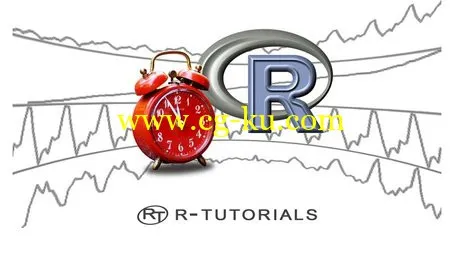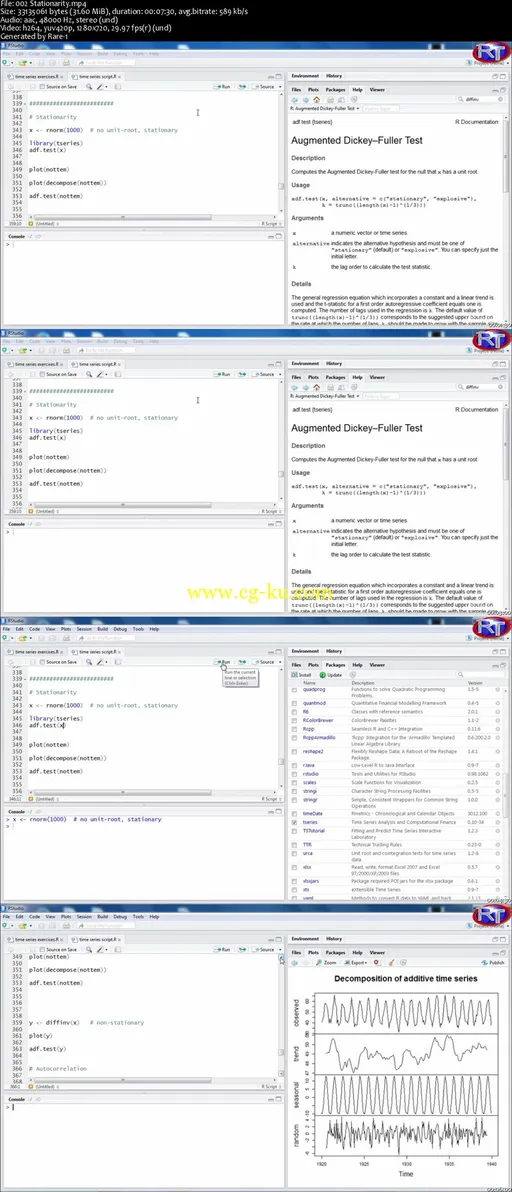
Time Series Analysis and Forecasting in R
WEBRip | MP4/AVC, ~527 kb/s | 1280 x 720 | English: AAC, 59.4 kb/s (2 ch), 48.0 KHz | 641 MB
Genre: Business / Data & Analytics | Language: English | +Project Files
Learn how to work with time series and all sorts of time related data in R - Forecasting, Time Series Analysis and more
Time series analysis and forecasting is one of the key fields in statistical programming. It allows you to
see patterns in time series data
model this data
finally make forecasts based on those models
Due to modern technology the amount of available data grows substantially from day to day. Successful companies know that. They also know that decisions based on data gained in the past, and modeled for the future, can make a huge difference. Proper understanding and training in time series analysis and forecasting will give you the power to understand and create those models. This can make you an invaluable asset for your company/institution and can boost your career!
What will you learn in this course and how is it structured?
You will learn about different ways in how you can
handle date and time data
in R. Things like time zones, leap years or different formats make calculations with dates and time especially tricky for the programmer. You will learn about POSIXt classes in R Base, the chron package and especially the lubridate package.
After that you will learn about
statistical methods
used for time series. You will hear about autocorrelation, stationarity and unit root tests.
Then you will see how different
models
work, how they are set up in R and how you can use them for
forecasting
. Of course all of this is accompanied with plenty
of exercises
.
Where are those methods applied?
In nearly any quantitatively working field you will see those methods applied. Especially econometrics and finance love time series analysis. For example stock data has a time component which makes this sort of data a prime target for forecasting techniques. But of course also in academia, medicine, business or marketing techniques taught in this course are applied.
Is it hard to understand and learn those methods?
Unfortunately learning material on Time Series Analysis Programming in R is quite technical and needs tons of prior knowledge to be understood.
With this course it is the goal to make understanding modeling and forecasting as
intuitive
and
simple
as possible for you.
While you need some knowledge in statistics and statistical programming, the course is meant for people without a major in a quantitative field like math or statistics. Basically anybody dealing with time data on a regular basis can benefit from this course.
How do I prepare best to benefit from this course?
It depends on your prior knowledge. But as a rule of thumb you should know how to handle standard tasks in R (courses R Basics and R Level 1).
For special offers and combinations just check out the
r-tutorials webpage
which you can find below the instructor profile.
What R you waiting for?
Martin
What are the requirements?
computer with R and RStudio ready to use
interest in statistics and programming
time to solve the exercises
basic knowledge of R (courses R Base and Level 1)
What am I going to get from this course?
Over 27 lectures and 2.5 hours of content!
use R to perform calculations with time and date based data
create models for time series data
use models for forecasting
identify which models are suitable for a given dataset
visualize time series data
transform standard data into time series format
What is the target audience?
this course is for people working with time series data
this course is for people interested in the R statistical software
this course is for people with beginner knowledge in both R programming and statistics
this course is for people working in various fields like (and not limited to): academia, marketing, business, econometrics, finance, medicine, engineering and science
Curriculum
Section 1: Introduction
Lecture 1 Intro Video 03:12
Lecture 2 Time Series R Task View
Lecture 3 Datasets to be used 07:21
Lecture 4 Course Links Text
Section 2: Working With Dates And Time In R
Lecture 5 POSIXt, Date, Chron Classes 08:50
Lecture 6 Lubridate: Input and Time Zones 05:03
Lecture 7 Lubridate: Weekdays and Intervals 02:48
Lecture 8 Lubridate: Exercise Dataframe 03:10
Lecture 9 Lubridate: Calculations and Leap Years 04:33
Lecture 10 Lubridate: Exercise Data Handling 03:33
Lecture 11 Section Script TD Text
Section 3: Statistical Background For Time Series And Forecasting
Lecture 12 Time Series Characteristics 05:29
Lecture 13 Stationarity 07:30
Lecture 14 Autocorrelation 07:35
Lecture 15 Acf and Pacf 06:23
Lecture 16 Section Script STAT Text
Section 4: Time Series Analysis And Forecasting
Lecture 17 Time Series Analysis - Basics 08:54
Lecture 18 Preparing your Dataset 03:06
Lecture 19 Decomposing a Seasonal Time Series
Lecture 20 Time Series Plots 03:41
Lecture 21 Simple Moving Average 04:25
Lecture 22 ARIMA - Basics 06:42
Lecture 23 ARIMA Coding and Model Selection
Lecture 24 ARIMA Forecasting 05:04
Lecture 25 Simple Exponential Smoothing 08:57
Lecture 26 Holt Winters Exponential Smoothing 05:06
Lecture 27 Section Script TSA Text

发布日期: 2015-12-22